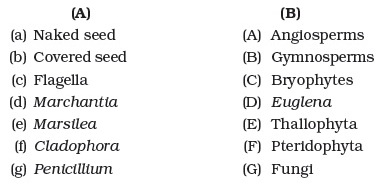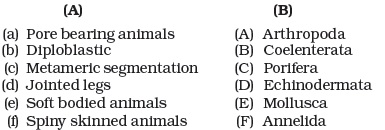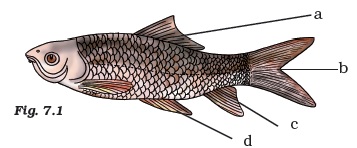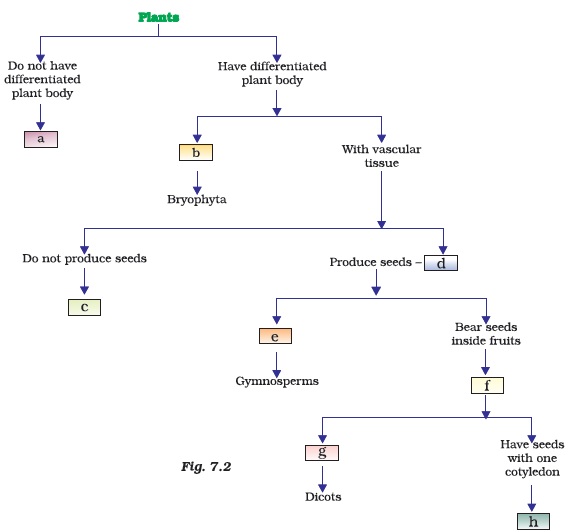In this page you can get all the information regarding the NCERT Exemplar Class 9 Science Unit 7. Here, some of the latest resources of NCERT Exemplar is provided on this page for free-of-cost. All the specific topics are covered in the provided resources. NCERT Exemplar Class 9 Science Unit 7 is a free resource which is very helpful while preparing for your upcoming examination. So, go through the entire page & read it thoroughly for more clarification.
NCERT Exemplar Class 9 Science Unit 7 Diversity In Living Organisms
We have given the NCERT Exemplar for Class 09 for Science topic and there is provided the Unit 7 Diversity In Living Organisms, have the multiple-choice question and very short type question and short type questions, etc., Students can practice through the exemplar which is given on this page. It help the students to analyse the subjects wise topic-based NCERT Exemplar.
Also Check NCERT Solutions for Class 9 Science
Multiple Choice Questions
- Find out incorrect sentence
(a) Protista includes unicellular eukaryotic organisms
(b) Whittaker considered cell structure, mode and source of nutrition for classifying the organisms in five kingdoms
(c) Both Monera and Protista may be autotrophic and heterotrophic
(d) Monerans have well defined nucleus - Which among the following has specialised tissue for conduction of water?
(i) Thallophyta
(ii) Bryophyta
(iii) Pteridophyta
(iv) Gymnosperms
(a) (i) and (ii)
(b) (ii) and (iii)
(c) (iii) and (iv)
(d) (i) and (iv) - Which among the following produce seeds?
(a) Thallophyta
(b) Bryophyta
(c) Pteridophyta
(d) Gymnosperms - Which one is a true fish?
(a) Jellyfish
(b) Starfish
(c) Dogfish
(d) Silverfish - Which among the following is exclusively marine?
(a) Porifera
(b) Echinodermata
(c) Mollusca
(d) Pisces - Which among the following have open circulatory system?
(i) Arthropoda
(ii) Mollusca
(iii) Annelida
(iv) Coelenterata
(a) (i) and (ii)
(b) (iii) and (iv)
(c) (i) and (iii)
(d) (ii) and (iv) - In which group of animals, coelom is filled with blood?
(a) Arthropoda
(b) Annelida
(c) Nematoda
(d) Echinodermata - Elephantiasis is caused by
(a) Wuchereria
(b) Pinworm
(c) Planarians
(d) Liver flukes - Which one is the most striking or (common) character of the vertebrates?
(a) Presence of notochord
(b) Presence of triploblastic condition
(c) Presence of gill pouches
(d) Presence of coelom - Which among the following have scales?
(i) Amphibians
(ii) Pisces
(iii) Reptiles
(iv) Mammals
(a) (i) and (iii)
(b) (iii) and (iv)
(c) (ii) and (iii)
(d) (i) and (ii) - Find out the false statement
(a) Aves are warm blooded, egg laying and have four chambered heart
(b) Aves have feather covered body, fore limbs are modified as wing and breathe through lungs
(c) Most of the mammals are viviparous
(d) Fishes, amphibians and reptiles are oviparous - Pteridophyta do not have
(a) root
(b) stem
(c) flowers
(d) leaves - Identify a member of porifera
(a) Spongilla
(b) Euglena
(c) Penicillium
(d) Hydra - Which is not an aquatic animal?
(a) Hydra
(b) Jelly fish
(c) Corals
(d) Filaria - Amphibians do not have the following
(a) Three chambered heart
(b) Gills or lungs
(c) Scales
(d) Mucus glands - Organisms without nucleus and cell organelles belong to
(i) fungi
(ii) protista
(iii) cyano bacteria
(iv) archae bacteria
(a) (i) and (ii)
(b) (iii) and (iv)
(c) (i) and (iv)
(d) (ii) and (iii) - Which of the following is not a criterion for classification of living organisms?
(a) Body design of the organism
(b) Ability to produce one’s own food
(c) Membrane bound nucleus and cell organelles
(d) Height of the plant - The feature that is not a characteristic of protochordata?
(a) Presence of notochord
(b) Bilateral symmetry and coelom
(c) Jointed legs
(d) Presence of circulatory system - The locomotory organs of Echinoderms are
(a) tube feet
(b) muscular feet
(c) jointed legs
(d) parapodia - Corals are
(a) Poriferans attached to some solid support
(b) Cnidarians, that are solitary living
(c) Poriferans present at the sea bed
(d) Cnidarians that live in colonies - Who introduced the system of scientific nomenclature of organisms
(a) Robert Whittaker
(b) Carolus Linnaeus
(c) Robert Hooke
(d) Ernst Haeckel - Two chambered heart occurs in
(a) crocodiles
(b) fish
(c) aves
(d) amphibians - Skeleton is made entirely of cartilage in
(a) Sharks
(b) Tuna
(c) Rohu
(d) None of these - One of the following is not an Annelid
(a) Nereis
(b) Earthworm
(c) Leech
(d) Urchins - The book Systema Naturae was written by
(a) Linnaeus
(b) Haeckel
(c) Whittaker
(d) Robert Brown - Karl Von Linne was involved with which branch of science?
(a) Morphology
(b) Taxonomy
(c) Physiology
(d) Medicine - Real organs are absent in
(a) Mollusca
(b) Coelenterata
(c) Arthropoda
(d) Echinodermata - Hard calcium carbonate structures are used as skeleton by
(a) Echinodermata
(b) Protochordata
(c) Arthropoda
(d) Nematoda - Differentiation in segmental fashion occurs in
(a) Leech
(b) Starfish
(c) Snails
(d) Ascaris - In taxonomic hierarchy family comes between
(a) Class and Order
(b) Order and Genus
(c) Genus and Species
(d) Division and Class - 5-Kingdom classification has given by
(a) Morgan
(b) R. Whittaker
(c) Linnaeus
(d) Haeckel - Well defined nucleus is absent in
(a) blue green algae
(b) diatoms
(c) algae
(d) yeast - The ‘Origin of Species’ is written by
(a) Linnaeus
(b) Darwin
(c) Hackel
(d) Whittaker - Meena and Hari observed an animal in their garden. Hari called it an insect while Meena said it was an earthworm. Choose the character from the following which confirms that it is an insect.
(a) Bilateral symmetrical body
(b) Body with jointed legs
(c) Cylindrical body
(d) Body with little segmentation
Short Answer Type Questions
- Write true (T) or false (F)
(a) Whittaker proposed five kingdom classification.
(b) Monera is divided into Archaebacteria and Eubacteria.
(c) Starting from Class, Species comes before the Genus.
(d) Anabaena belongs to the kingdom Monera.
(e) Blue green algae belongs to the kingdom Protista.
(f) All prokaryotes are classified under Monera. - Fill in the blanks
(a) Fungi shows ____ mode of nutrition.
(b) Cell wall of fungi is made up of ____ .
(c) Association between blue green algae and fungi is called as ____ .
(d) Chemical nature of chitin is ____ .
(e) ____ has smallest number of organisms with maximum number of similar characters
(f) Plants without well differentiated stem, root and leaf are kept in ____ .
(g) ____ are called as amphibians of the plant kingdom. - You are provided with the seeds of gram, wheat, rice, pumpkin, maize and pea. Classify them whether they are monocot or dicot.
- Match items of column (A) with items of column (B)

- Match items of column (A) with items of column (B)

- Classify the following organisms based on the absence/presence of true coelom (i.e., acoelomate, pseudocoelomate and coelomate)

- Endoskeleton of fishes are made up of cartilage and bone; classify the following fishes as cartilaginous or bony

- Classify the following based on number of chambers in their heart.
Rohu, Scoliodon, Frog, Salamander, Flying lizard, King Cobra, Crocodile, Ostrich, Pigeon, Bat, Whale - Classify Rohu, Scolidon, Flying lizard, King Kobra, Frog, Salamander,
Ostrich, Pigeon, Bat, Crocodile and Whale into the cold blooded/warm blooded animals. - Name two egg laying mammals.
- Fill in the blanks
(a) Five kingdom classification of living organisms is given by ____ .
(b) Basic smallest unit of classification is ____ .
(c) Prokaryotes are grouped in Kingdom ____ .
(d) Paramecium is a protist because of its ____ .
(e) Fungi do not contain ____ .
(f) A fungus ____ can be seen without microscope.
(g) Common fungi used in preparing the bread is ____ .
(h) Algae and fungi form symbiotic association called ____ . - Give True (T) and False (F)
(a) Gymnosperms differ from Angiosperms in having covered seed.
(b) Non flowering plants are called Cryptogamae.
(c) Bryophytes have conducting tissue.
(d) Funaria is a moss.
(e) Compound leaves are found in many ferns.
(f) Seeds contain embryo. - Give examples for the following
(a) Bilateral, dorsiventral symmetry is found in ____ .
(b) Worms causing disease elephantiasis is ____ .
(c) Open circulatory system is found in ____ where coelomic cavity is filled with blood.
(d) ____ are known to have pseudocoelom. - Label a,b,c and d. given in Fig. 7.1 Give the function of (b)

- Fill in the boxes given in Fig. 7.2 with appropriate characteristics/plant group (s)

Long Answer Type Questions
- Write names of few thallophytes. Draw a labelled diagram of Spirogyra.
- Thallophyta, bryophyta and pteridophyta are called as ‘Cryptogams’. Gymnosperms and Angiosperms are called as ‘phanerogams’. Discuss why? Draw one example of Gymnosperm.
- Define the terms and give one example of each
(a) Bilateral symmetry
(b) Coelom
(c) Triploblastic - You are given leech, Nereis, Scolopendra, prawn and scorpion; and all have segmented body organisation. Will you classify them in one group? If no, give the important characters based on which you will separate these organisms into different groups.
- Which organism is more complex and evolved among Bacteria, Mushroom and Mango tree. Give reasons.
- Differentiate between flying lizard and bird. Draw the diagram.
- List out some common features in cat, rat and bat.
- Why do we keep both snake and turtle in the same class?
| « Previous | Next » |
Answers
To get study material, exam alerts and news, join our Whatsapp Channel.







